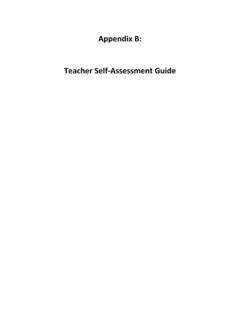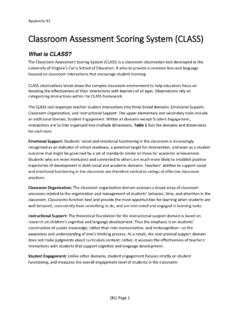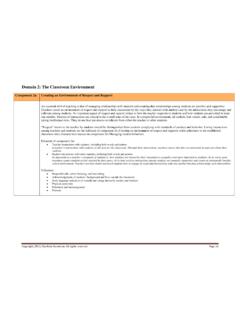Transcription of Comparison of Teacher Evaluation Models
1 Comparison of Teacher Evaluation Models New Jersey schools use a multitude of different Teacher Evaluation Models , including major frameworks recognized nationally and regionally and individual Models developed by school districts and approved by the state. NJ Spotlight (February, 2013) lists the most popular Models , from a total of 85% of districts reporting (496) at the time of the article. Five Models accounted for over 95% of districts reporting at that time. The five most popular Models are: 1. charlotte danielson framework for Teachers: 291 districts or 60% 2. Stronge Teacher and Leader Effectiveness Performance System: 53 districts or 11% 3. Mid-Continent Research for Education and Learning (McREL) Teacher Evaluation Standards: 45 districts or 9% 4. Marzano's Causal Teacher Evaluation Model: 44 districts or 9% 5. The Marshall Rubrics: 32 districts or charlotte danielson framework for Teachers The danielson framework consists of four domains: Planning and Preparation; The Classroom Environment; Instruction; and Professional Responsibilities.
2 These domains are broken down into a total of 22 components. Each component contains from one to five elements. The Planning and Preparation domain includes Teacher knowledge of content, students and resources, and designing instruction and instructional outcomes and student assessments. The Classroom Environment domain includes creating an environment of respect/rapport and culture for learning; managing classroom procedures and student behavior, and organizing space. The Instruction domain includes communicating and using question/discussion techniques with students, engaging students in learning, ongoing assessment, and showing flexibility/responsiveness. The Professional Responsibilities domain includes Teacher reflection, keeping records, communicating with families, and professional participation, integrity and growth. Stronge Teacher and Leader Effectiveness Performance System: The Stronge model is composed of seven performance standards: Professional Knowledge, Instructional Planning, Instructional Delivery, Assessment of/for Learning, the Learning Environment, Professionalism and Communication, and Student Progress.
3 The Professional Knowledge standard concerns Teacher understanding of curriculum, subject matter, pedagogical knowledge, and students developmental needs. The Instructional Planning standard concerns planning using state standards and the district curriculum, as well as appropriate resources, data and relevant strategies. The Instructional Delivery standard pertains to teachers use of varied instructional strategies effective in meeting individual learning needs. In Assessment of/for Learning, the standard pertains to the use of a variety of formative and summative assessment and the use of data. The Learning Environment standard concerns development of a safe, student-centered, academic environment conducive to learning (Stronge/NJEA Review, 2011, para. 6). The Professionalism and Communication pertains to professional ethics, growth and communication.
4 The Student Progress standard concerns commitment to and evidence of effective, standards-based student learning outcomes. Mid-Continent Research for Education and Learning (Morel) Teacher Evaluation Standards The McREL model consists of five standards, under which are a total of 25 elements. The standards and elements are statements of Teacher proficiencies. The standards are as follows: 1. Teachers Demonstrates Leadership; 2. Teachers establish a respectful environment for a diverse population of students; 3. Teachers know the content they teach; 4. Teachers facilitate learning for their students; 5. Teachers reflect on their practices. Standard 1 includes leadership in the classroom, school and profession, ethical standards and advocacy. Standard 2 includes providing a nurturing environment, embracing diversity, individualizing and adapting instruction and communicating with families.
5 Standard 3 includes content knowledge, alignment of instruction to standards, recognizing interconnections, and making instruction relevant to students. Standard 4 includes understanding how children develop and learn, planning appropriate instruction, using a variety of learning materials, integrating technology, and developing critical thinking. Standard 5 includes reflecting on practice, analyzing learning, professionalism and professional development, and effective institutional functioning. Marzano's Causal Teacher Evaluation Model The Marzano model comprises four domains, with 60 elements that are contained within segments or sub components of the domains. The four domains are: 1. Classroom strategies and behaviors; 2. Planning and Preparing; 3. Reflection on Teaching; 4. Collegiality and Professionalism. Classroom strategies and behaviors involves 41 elements on routines, content and on the spot behaviors demonstrated by teachers.
6 Planning and preparing includes 8 elements on lesson and unit planning use of technology and materials, and student (special) needs. Reflecting on teaching Includes 5 elements on self- Evaluation of performance and plan(s) for professional growth. Collegiality and Professionalism involves 6 elements on promotion of a positive environment, exchanging of ideas and school and district development. The Marshall Rubrics The Marshall model consists of a series of 10 rubrics in six domains. A. Planning and Preparation for Learning; B. Classroom Management; C. Delivery of Instruction; D. Monitoring, Assessment, and Follow-Up; E. Family and Community Outreach; F. Professional Responsibilities. Planning and Preparation for Learning includes planning of units and lessons, and assessments that anticipate student responses and engagement and differentiate learning.
7 Classroom Management includes building relationships and respect with students, developing positive student interactions and responsibility, and efficiently and providing varied and creative incentives for students. Delivery of Instruction includes having high expectations, clear goals and content, engaging students in learning, differentiating instruction, being nimble and summarizing learning. Monitoring, Assessment, and Follow-Up includes having clear assessment criteria and varied forms of assessment, analysis/diagnosis and follow up of data, support for students with special needs and reflecting on practice. Family and Community Outreach includes showing respect for, believing in and expecting family/community involvement, communication and outreach with stakeholders, and use of varied community resources. Professional Responsibilities includes high attendance, professional demeanor and judgment, collaboration, and professional/leadership growth and development.
8 The Following pages provide a table aligning the elements of the five Models described above to each other and to the New Jersey Professional Standards for Teachers. Comparison Table of Evaluation Models with Each Other and With the New Jersey Professional Teaching Standards danielson Stronge McREL Marzano Marshal NJ PTS Demonstrating Knowledge of Content & Pedagogy: i. Content knowledge The Teacher demonstrates an accurate knowledge of the subject matter Teachers know the content appropriate to their teaching specialty Teachers recognize the interconnectedness of content area/discipline Previewing New Content Processing of New Information Elaborating on New Information Recording and Representing Knowledge A. a. Knowledge Elements Prerequisite relationships The Teacher effectively addresses appropriate curriculum standards.
9 The Teacher integrates key content elements and facilitates students use of higher level thinking skills in instruction Teachers align their instruction with the New Jersey/Common Core Curriculum Content Standards and approved District curriculum Attention to Established Content Standards A. b. Standards Element Content pedagogy The Teacher demonstrates skills relevant to the subject area(s) taught Teachers know the content appropriate to their teaching specialty Chunking content into digestible bites A. g. Engagement Elements Demonstrating Knowledge of Students: i. Child development The Teacher demonstrates an understanding of the intellectual, social, emotional, and physical development of the age group Teachers know the ways in which learning takes place, and they know the appropriate levels of intellectual physical, social, and emotional development of their students Effective Scaffolding of Information with Lessons A.
10 I. Differentiation Elements Learning process The Teacher demonstrates ability to link present content with past and future learning experiences, other subject areas, and real world experiences and applications. Teachers make instruction relevant to students Effective Scaffolding of Information with Lessons A. c. Anticipation C. d. Connections Elements Special needs The Teacher plans for differentiated instruction Teachers embrace diversity in the school community and the world Demonstrating Value and Respect for Low Expectancy Students Needs of Students Receiving Special Education A. c. Anticipation A. i. Differentiation D. h. Support Element Elements student skills, knowledge & proficiency The Teacher demonstrates an understanding of the intellectual, social, emotional, and physical development of the age group The Teacher builds upon students existing knowledge and skills Teachers treat students as individuals Teachers know the ways in which learning takes place, and they know the appropriate levels of intellectual physical, social, and emotional development of their students Examining Similarities and Differences Examining Errors in Reasoning D.



